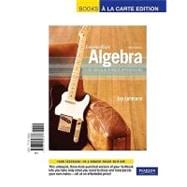
1. Linear Equations and Linear Functions
1.1 Using Qualitative Graphs to Describe Situations
1.2 Graphing Linear Equations
1.3 Slope of a Line
1.4 Meaning of Slope for Equations, Graphs, and Tables
1.5 Finding Linear Equations
1.6 Functions
Chapter Summary
Key Points of Chapter 1
Chapter 1 Review Exercises
Chapter 1 Test
2. Modeling with Linear Functions
2.1 Using Lines to Model Data
2.2 Finding Equations of Linear Models
2.3 Function Notation and Making Predictions
2.4 Slope Is a Rate of Change
Chapter Summary
Key Points of Chapter 2
Chapter 2 Review Exercises
Chapter 2 Test
3. Systems of Linear Equations
3.1 Using Graphs and Tables to Solve Systems
3.2 Using Substitution and Elimination to Solve Systems
3.3 Using Systems to Model Data
3.4 Value, Interest, and Mixture Problems
3.5 Using Linear Inequalities in One Variable to Make Predictions
Chapter Summary
Key Points of Chapter 3
Chapter 3 Review Exercises
Chapter 3 Test
Cumulative Review of Chapters 1–3
4. Exponential Functions
4.1 Properties of Exponents
4.2 Rational Exponents
4.3 Graphing Exponential Functions
4.4 Finding Equations of Exponential Functions
4.5 Using Exponential Functions to Model Data
Chapter Summary
Key Points of Chapter 4
Chapter 4 Review Exercises
Chapter 4 Test
5. Logarithmic Functions
5.1 Inverse Functions
5.2 Logarithmic Functions
5.3 Properties of Logarithms
5.4 Using the Power Property with Exponential Models to Make Predictions
5.5 More Properties of Logarithms
5.6 Natural Logarithms
Chapter Summary
Key Points of Chapter 5
Chapter 5 Review Exercises
Chapter 5 Test
Cumulative Review of Chapters 1–5
6. Polynomial Functions
6.1 Adding and Subtracting Polynomial Expressions and Functions
6.2 Multiplying Polynomial Expressions and Functions
6.3 Factoring Trinomials of the Form x2 + bx + c; Factoring out the GCF
6.4 Factoring Polynomials
6.5 Factoring Special Binomials; A Factoring Strategy
6.6 Using Factoring to Solve Polynomial Equations
Chapter Summary
Key Points of Chapter 6
Chapter 6 Review Exercises
Chapter 6 Test
7. Quadratic Functions
7.1 Graphing Quadratic Functions in Vertex Form
7.2 Graphing Quadratic Functions in Standard Form
7.3 Using the Square Root Property to Solve Quadratic Equations
7.4 Solving Quadratic Equations by Completing the Square
7.5 Using the Quadratic Formula to Solve Quadratic Equations
7.6 Solving Systems of Linear Equations in Three Variables; Finding Quadratic Functions
7.7 Finding Quadratic Models
7.8 Modeling with Quadratic Functions
Chapter Summary
Key Points of Chapter 7
Chapter 7 Review Exercises
Chapter 7 Test
Cumulative Review of Chapters 1–7
8. Rational Functions
8.1 Finding the Domains of Rational Functions and Simplifying
Rational Expressions
8.2 Multiplying and Dividing Rational Expressions
8.3 Adding and Subtracting Rational Expressions
8.4 Simplifying Complex Rational Expressions
8.5 Solving Rational Equations
8.6 Modeling with Rational Functions
8.7 Variation
Chapter Summary
Key Points of Chapter 8
Chapter 8 Review Exercises
Chapter 8 Test
9. Radical Functions
9.1 Simplifying Radical Expressions
9.2 Adding, Subtracting, and Multiplying Radical Expressions
9.3 Rationalizing Denominators and Simplifying Quotients of Radical Expressions
9.4 Graphing and Combining Square Root Functions
9.5 Solving Radical Equations
9.6 Modeling with Square Root Functions
Chapter Summary
Key Points of Chapter 9
Chapter 9 Review Exercises
Chapter 9 Test
10. Sequences and Series
10.1 Arithmetic Sequences
10.2 Geometric Sequences
10.3 Arithmetic Series
10.4 Geometric Series
Chapter Summary
Key Points of Chapter 10
Chapter 10 Review Exercises
Chapter 10 Test
Cumulative Review of Chapters 1–10
11. Additional Topics
11.1 Absolute Value: Equations and Inequalities
Key Points of Section 11.1
11.2 Linear Inequalities in Two Variables; Systems of Linear Inequalities
Key Points of Section 11.2
11.3 Performing Operations with Complex Numbers
Key Points of Section 11.3
11.4 Pythagorean Theorem, Distance Formula, and Circles
Key Points of Section 11.4
11.5 Ellipses and Hyperbolas
Key Points of Section 11.5
11.6 Solving Nonlinear Systems of Equations
Key Points of Section 11.6
A. Reviewing Prerequisite Material
A.1 Plotting Points
A.2 Identifying Types of Numbers
A.3 Absolute Value
A.4 Performing Operations with Real Numbers
A.5 Exponents
A.6 Order of Operations
A.7 Constants, Variables, Expressions, and Equations
A.8 Distributive Law
A.9 Combining Like Terms
A.10 Solving Linear Equations in One Variable
A.11 Solving Equations in Two or More Variables
A.12 Equivalent Expressions and Equivalent Equations
B Using a TI-83 or TI-84 Graphing Calculator
B.1 Turning a Graphing Calculator On or Off
B.2 Making the Screen Lighter or Darker
B.3 Entering an Equation
B.4 Graphing an Equation
B.5 Tracing a Curve without a Scattergram
B.6 Zooming
B.7 Setting the Window Format
B.8 Plotting Points in a Scattergram
B.9 Tracing a Scattergram
B.10 Graphing Equations with a Scattergram
B.11 Tracing a Curve with a Scattergram
B.12 Turning a Plotter On or Off
B.13 Creating a Table
B.14 Creating a Table for Two Equations
B.15 Using “Ask” in a Table
B.16 Finding the Regression Curve for Some Data
B.17 Plotting Points in Two Scattergrams
B.18 Finding the Intersection Point(s) of Two Curves
B.19 Finding the Minimum Point(s) or Maximum Point(s) of a Curve
B.20 Storing a Value
B.21 Finding Any x-Intercepts of a Curve
B.22 Turning an Equation On or Off
B.23 Finding Coordinates of Points
B.24 Graphing Equations with Axes “Turned Off”
B.25 Entering an Equation by Using Yn References
B.26 Responding to Error Messages
The New copy of this book will include any supplemental materials advertised. Please check the title of the book to determine if it should include any access cards, study guides, lab manuals, CDs, etc.
The Used, Rental and eBook copies of this book are not guaranteed to include any supplemental materials. Typically, only the book itself is included. This is true even if the title states it includes any access cards, study guides, lab manuals, CDs, etc.